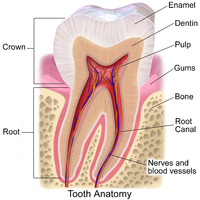
Photo from wikipedia
Supplemental Digital Content is Available in the Text. Purpose: The aim of the current research was to measure the thickness of the residual central corneal bed after performing the manual… Click to show full abstract
Supplemental Digital Content is Available in the Text. Purpose: The aim of the current research was to measure the thickness of the residual central corneal bed after performing the manual “Groove and Peel” deep anterior lamellar keratoplasty (GP-DALK) technique on human cadaveric eyes. Methods: The manual GP-DALK technique was performed on 6 human cadaver eyes by an experienced corneal surgeon. After surgery, the eye globes were fixed in 10% buffered formalin and embedded in paraffin. For each eye, 4-μm-thick hematoxylin and eosin sections involving the pupillary axis were obtained and examined. Using an image-processing software, 2 observers measured the corneal thickness of the residual central corneal bed and the peripheral corneal rims. Results: The overall mean central corneal bed thickness was 35.5 ± 12.9 μm, whereas the mean right and left peripheral rim thicknesses were 993.0 ± 141.1 and 989.3 ± 147.1 μm, respectively (P = 0.0006). In most corneas, the level of dissection reached almost to the pre-Descemetic collagen (Dua) layer. Conclusions: The GP-DALK technique is effective in removing most of the corneal stroma and may be non-inferior to “big-bubble” deep anterior lamellar keratoplasty in some cases.
Journal Title: Cornea
Year Published: 2022
Link to full text (if available)
Share on Social Media: Sign Up to like & get
recommendations!